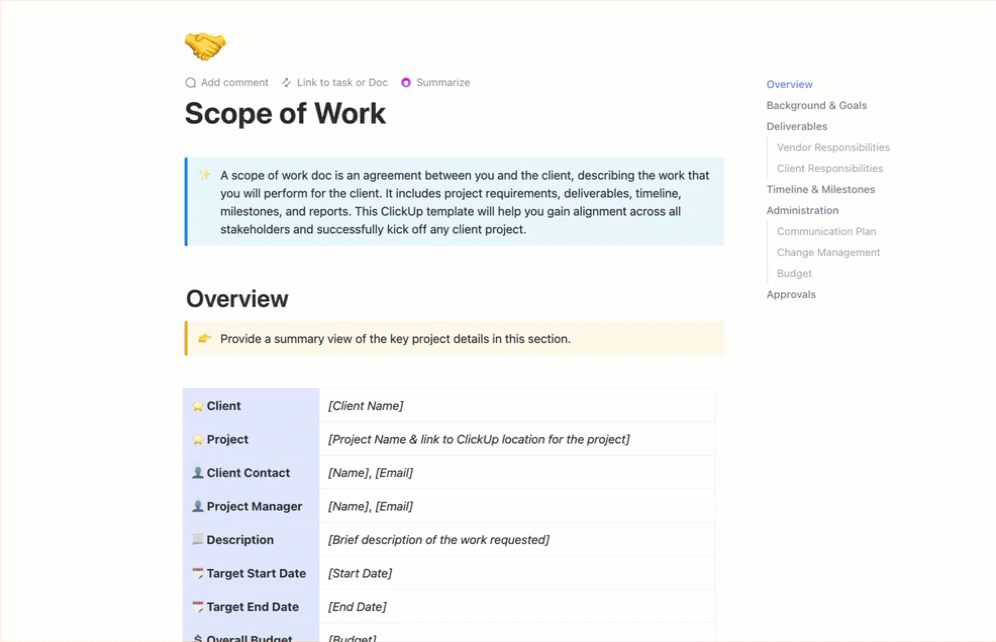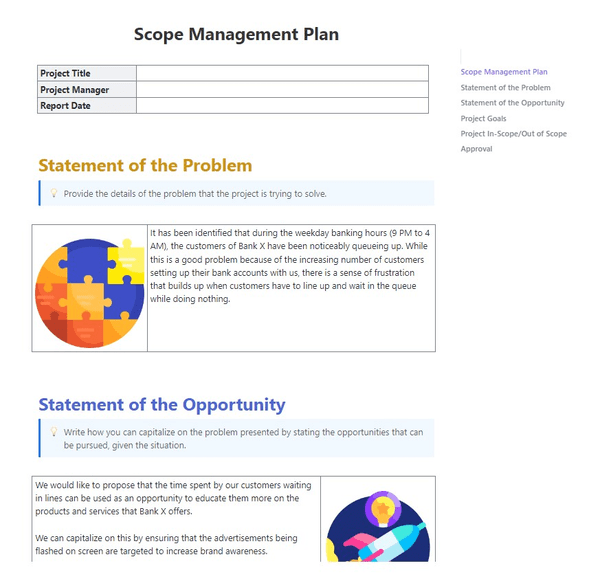Ever kicked off a project only to realize halfway through that expectations aren’t aligned, deadlines are slipping, and the budget is spiraling out of control? 😵💫
Studies show that only 29% of projects are completed successfully, while the rest suffer from scope creep, miscommunication, or lack of clear objectives.
The solution? A well-defined project scope. 🎯
It sets boundaries, aligns teams, and ensures your project stays on time, within budget, and meets expectations. Without it, you’re flying blind!
This guide will walk you through what a project scope is, why it’s essential, and how to write one effectively (without the headache!). 💪
Understanding Project Scope
Project scope defines all the work required to complete a project successfully. It outlines specific goals, deliverables, tasks, costs, and deadlines. This clear framework ensures project managers know what’s expected, keeping the project on track and within budget.
Project scope vs. scope management
📌 While project scope defines ‘what needs to be done,’ scope management helps project managers determine ‘how it will be controlled.’
Here’s a side-by-side comparison:
| Aspect | Project Scope 🎯 | Scope Management 🛠️ |
| Definition | A detailed outline of work and project deliverables | The process of defining, controlling, and monitoring scope |
| Purpose | Sets project boundaries and expectations | Ensures the project stays on course |
| Focus | What needs to be done | How changes and challenges are handled |
| Outcome | Clear project objectives | Controlled changes and minimized scope creep |
💡 In short, defining project scope is just the first step. Managing it properly is what ensures success!
Common challenges in defining project scope
Even with a well-defined scope, challenges can arise. Here are some common pitfalls that project managers often face:
- Miscommunication: Team members misunderstanding project boundaries
- Unclear objectives: Vague goals leading to confusion and misaligned efforts
- Stakeholder changes: New demands or shifts in expectations mid-project
- Inadequate risk management: Overlooking potential obstacles that affect the scope
- Scope creep: Uncontrolled changes expanding the project beyond its original objectives
🔍 Did You Know? 📊 A study by PMI found that poor project scope management is a leading cause of project failure, affecting 35% of projects!
The Benefits of Defining Project Scope Early
Here are the top benefits of defining your project scope from the get-go ⬇️
- Enhanced team alignment: With a clear project scope, everyone knows their role. This reduces confusion and ensures the project team works together smoothly 🤝
- Improved resource management: Knowing the project’s boundaries allows for efficient distribution of resources, preventing overallocation or shortages 📈
- Risk mitigation: Identifying project constraints early helps anticipate potential project management challenges, enabling project managers to devise effective mitigation strategies 🚨
- Stakeholder satisfaction: Clearly outlining project deliverables and objectives ensures stakeholders are on the same page, leading to higher satisfaction and trust 😊
Steps to Define Project Scope
Let’s break down how to define your project scope document in the right way to ensure smooth execution and successful delivery 👇
1. Start with project objectives and goals 🎯
Clear objectives and goals are the foundation of any well-defined project scope.
Project objectives are specific, measurable outcomes that your project aims to achieve. They define what success looks like and ensure every step you take is purposeful. On the other hand, project goals are broader aspirations that describe the project’s overall mission.
While objectives are detailed and specific, goals give a high-level idea of the desired result.
For example, if you are launching an e-commerce website,
- Goal: Create a user-friendly shopping experience that increases sales 🎯
- Objective: Achieve a 20% boost in conversion rates within six months while maintaining an optimized project budget ✅

To ensure your objectives and goals are rock solid, follow these best practices:
- Use the SMART (Specific, Measurable, Achievable, Relevant, and Time-Bound) criteria 🧠
- Align objectives with business and stakeholder needs 🤝
- Break your objectives into smaller milestones 📆
- Avoid setting too many or too few objectives ⚖️
When done right, this ensures alignment, efficiency, and success throughout your project life cycle.
2. Create a resource plan 🛠️
Once you’ve set clear objectives and goals, determine what you need to achieve them. This is where creating a resource plan becomes crucial.
A resource plan outlines all the resources—people, equipment, materials, and budget—required to complete your project. It details:
- What resources are needed
- When they’re needed
- How much of each resource is required
Here’s how to create a resource management plan:
- Identify what you need: Start by listing all the tasks involved in your project. Then, determine what resources each task requires. This could include team members, tools, software, materials, or even office space 🕵️♀️
- Estimate the amount needed: Once you know what you need, determine how much of each resource is required. Some tasks may take more time or manpower than others, so be realistic in your estimates 📏
- Schedule resources smartly: Now, match your resource needs to your project timeline. Make sure people aren’t overbooked and that equipment is available when required 📆
- Keep an eye on everything: Resources are never static. Someone may call in sick, project management software may need updates, or a vendor might delay delivery. Regularly review your resource plan and adjust when needed 🔄
To make resource planning even more efficient, you can use work breakdown structure templates to help break projects down into manageable phases.
3. Collect additional project requirements 📝
70% of project failures are due to poor requirement gathering. Collecting comprehensive project requirements ensures the final deliverable aligns with stakeholder expectations and project goals. The clearer the picture, the smoother the process!

To collect additional project requirements:
- Identify project stakeholders: Stakeholders could be clients, internal teams, end-users, or investors—anyone impacted by the project. Talking to them helps you understand their expectations, pain points, and must-haves 👥
- Conduct requirement elicitation sessions: Gather information through interviews, surveys, workshops, or even simple observation of how users interact with current systems 🗣️
- Document everything clearly: The next step is to document everything clearly. A well-written requirement should be specific, realistic, and unambiguous. You can also use visual aids like flowcharts or wireframes to make complex ideas easier to understand 📝
💡 Pro Tip: Use the “MOSCOW method” (Must have, Should have, Could have, Won’t have) to prioritize requirements with stakeholders before project kickoff.
ClickUp Brain instantly summarizes stakeholder inputs, highlights missing details, and organizes insights in your project scope document for better decision-making.

4. Draft the project scope statement 🔖
Now it’s time to create a project scope statement that defines the project’s objectives, project deliverables, boundaries, and key milestones. It’s a reference point for stakeholders and project managers, helping manage expectations and guide decision-making.
Key elements to include in your project scope document are:
- Project objectives: State what the project aims to achieve in specific, measurable terms 🎯
- Deliverables: Detail the products, services, or results the project will produce 📦
- Scope description: Specify what is included and not included in the project to prevent misunderstandings 🖋️
- Acceptance criteria: Define the conditions that must be met for deliverables to be accepted ✅
- Constraints and assumptions: Identify any restrictions (e.g., budget, time) and assumptions that could impact the project ⏳
- Milestones: Mark significant points or phases in the project planning timeline 📅
💡 Pro Tip: When defining your project scope, create a visual ‘Scope Boundary Map’ using a simple two-column format that outlines what’s ‘In Scope’ and ‘Out of Scope’ for each deliverable.
If you need a project scope example, consider a website redesign where ‘In Scope’ includes UI updates and mobile responsiveness, while ‘Out of Scope’ might exclude backend system changes.
5. Obtain buy-in and approval from key stakeholders 🤝
62% of successful projects have strong stakeholder involvement.
Keeping stakeholders informed about the project’s objectives, scope, and expected outcomes builds trust. However, this doesn’t mean bombarding them with endless reports—regular updates, short meetings, and clear, concise documentation go a long way toward keeping everyone aligned.
Also, securing buy-in is about demonstrating the project’s value. Show how it benefits the company, solves a problem, or meets a business goal. Stakeholders who see a direct positive impact are more likely to support it.
If there are concerns, be open to feedback and willing to adjust the project’s scope where necessary. When stakeholders feel heard and included, approval becomes a natural step rather than a hurdle.
6. Establish a change control process 🔄
In project management, change is inevitable. Projects must adapt, whether it’s a shift in client requirements, market conditions, or unforeseen challenges. But without a structured approach, these changes can lead to confusion, delays, and budget overruns.
That’s why a change control process is essential.
It’s a formal procedure for identifying, evaluating, and managing changes in a project’s scope, timeline, or resources. It ensures every proposed modification is thoroughly assessed and approved before implementation, maintaining the project’s integrity and alignment with its original objectives.
7. Share and communicate the project scope statement with all concerned 📢
56% of project failures are due to poor communication.
When done right, sharing and communicating the scope statement ensures all relevant stakeholders (project team members, clients, and management) are aligned and working towards the same goals.
Some of the best ways to share and communicate the project scope statement include:
- Schedule a project kickoff meeting. Bring all key stakeholders together and walk them through the document 📅
- Use visuals like flowcharts, Gantt charts, and infographics to make the scope statements easier to digest 📊
- Store your scope statement in a centralized project management tool. This way, if anyone has questions about the project scope, they know exactly where to find the answer 📂
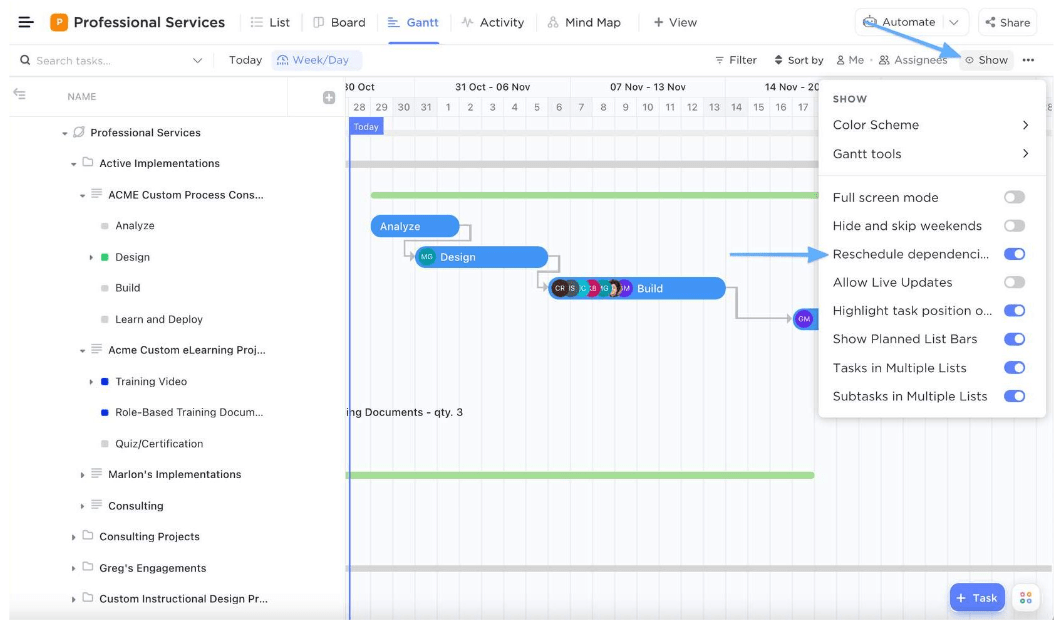
8. Monitor and refer back to the project scope statement at frequent intervals 🔍
Regularly check your project scope statement. To effectively monitor it, here’s what you need to do:
- Establish clear metrics and baselines: Set measurable goals for time, cost, and quality based on the scope statement. Use these criteria to form benchmarks to measure progress 📏
- Regularly compare progress against the scope statement: Schedule consistent check-ins to assess alignment with the scope 📊
- Identify and address deviations promptly: Look for misalignment signs. Adjust plans or resources to steer the project back on course 🚨
- Document lessons learned for future projects: Note what worked and what didn’t for future reference. Use these insights to improve scope management in upcoming projects 📝
Tools and Templates for Project Scope Management
Without a clear scope, priorities shift, and teams end up working on things that were never planned. This is when you need a solution that helps you define, track, and manage project scope seamlessly to keep everything on course.
Enter ClickUp, the everything app for work. From project scope templates to built-in collaboration, automation, and knowledge management—all powered by AI—ClickUp gives you complete control over your project’s boundaries.
Let’s see how:
ClickUp’s Scope of Work Template 📄
A Scope of Work (SOW) Template is essential for defining project objectives, deliverables, and timelines. Without it, team members may not fully understand their project roles, leading to misalignment and wasted effort.
ClickUp’s Scope of Work Template provides a structured framework to ensure clarity and efficiency from day one.
The highlights of this project scope template include:
- Pre-built structure: Use this ready-to-use project scope template with essential details like objectives, key deliverables, constraints, timelines, and approval processes, so you don’t have to start from scratch
- Custom statuses: Track every phase of your project with statuses like Planning, In Review, Approved, In Progress, and Completed to ensure everyone knows where things stand
- Task assignments: Assign specific deliverables, milestones, and dependencies to team members directly in ClickUp, ensuring ownership
- Automation and alerts: Set up automatic reminders for scope reviews, trigger notifications when a task moves between phases, and flag scope creep before it derails the project
ClickUp’s Scope Management Plan Template 📋
Even better, ClickUp’s Scope Management Plan Template provides an easy way to define, control, and monitor your project’s scope while keeping everything in one place.
In a nutshell,
- Customizable: Get ready-made fields to outline objectives, deliverables, and constraints
- Assigned tasks: Easily map out who’s responsible for what, ensuring everyone stays aligned and accountable
- Progress tracking: Set deadlines, track milestones, and get a visual overview of progress to keep your project moving forward
- Budget control: Keep financials in check with built-in budget tracking so you can spot cost overruns before they happen
Using ClickUp’s features for project scope management
ClickUp provides powerful features that help teams define, track, and monitor scope effectively in one place.
Task management for clarity in scope assignments ✅
Without proper task management software, teammates may not know what’s included in the project scope and what’s not. ClickUp’s Task Management feature ensures:
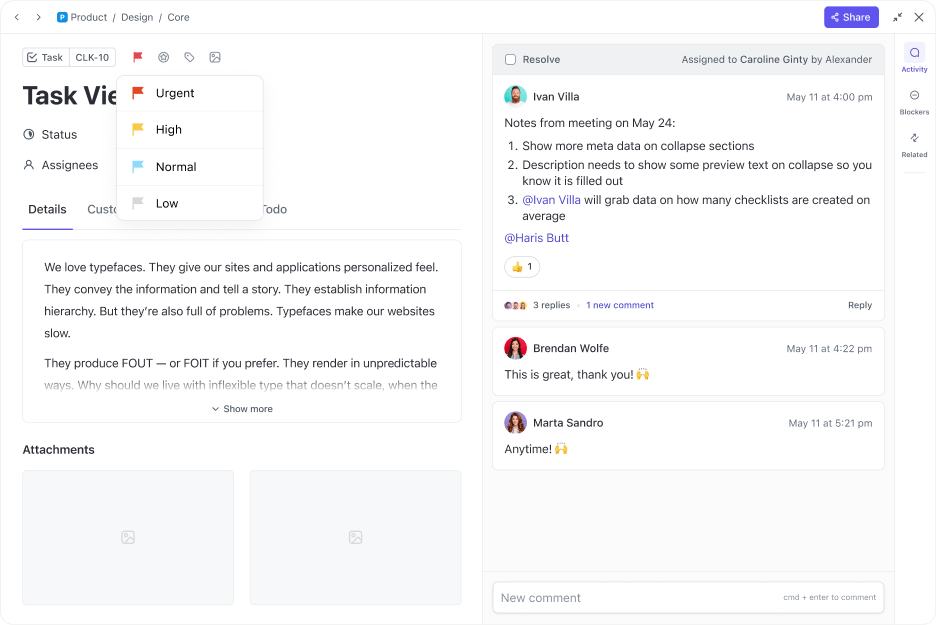
- Clearly assigned responsibilities: ClickUp Tasks are assigned to specific team members, eliminating confusion
- Task prioritization: Teams can prioritize work based on scope-critical deliverables
- Custom workflows: Set custom task statuses like To Do, In Progress, Review, and Completed for better tracking
💡 Example: If you’re developing a marketing project website, ClickUp helps assign tasks to designers, developers, and testers, ensuring everyone knows their exact role in the scope.
📮ClickUp Insight: 92% of knowledge workers risk losing important decisions scattered across chat, email, and spreadsheets.
Without a unified system for capturing and tracking decisions, critical business insights get lost in the digital noise. With ClickUp’s Task Management capabilities, you never have to worry about this. Create tasks from chat, task comments, docs, and emails with a single click!
Time tracking for resource allocation optimization ⏳
Keeping a project within scope and budget requires efficient resource planning. ClickUp Time Tracking allows teams to:
- Log time spent on tasks: Helps track work progress and identify scope deviations
- Estimate time needed: Teams can set estimated work hours for tasks to avoid delays
- Track billable hours: Essential for projects with outsourced or hourly-paid work

Custom dashboards for monitoring scope execution 📊
ClickUp Custom Dashboards provide real-time insights into project scope, helping teams:
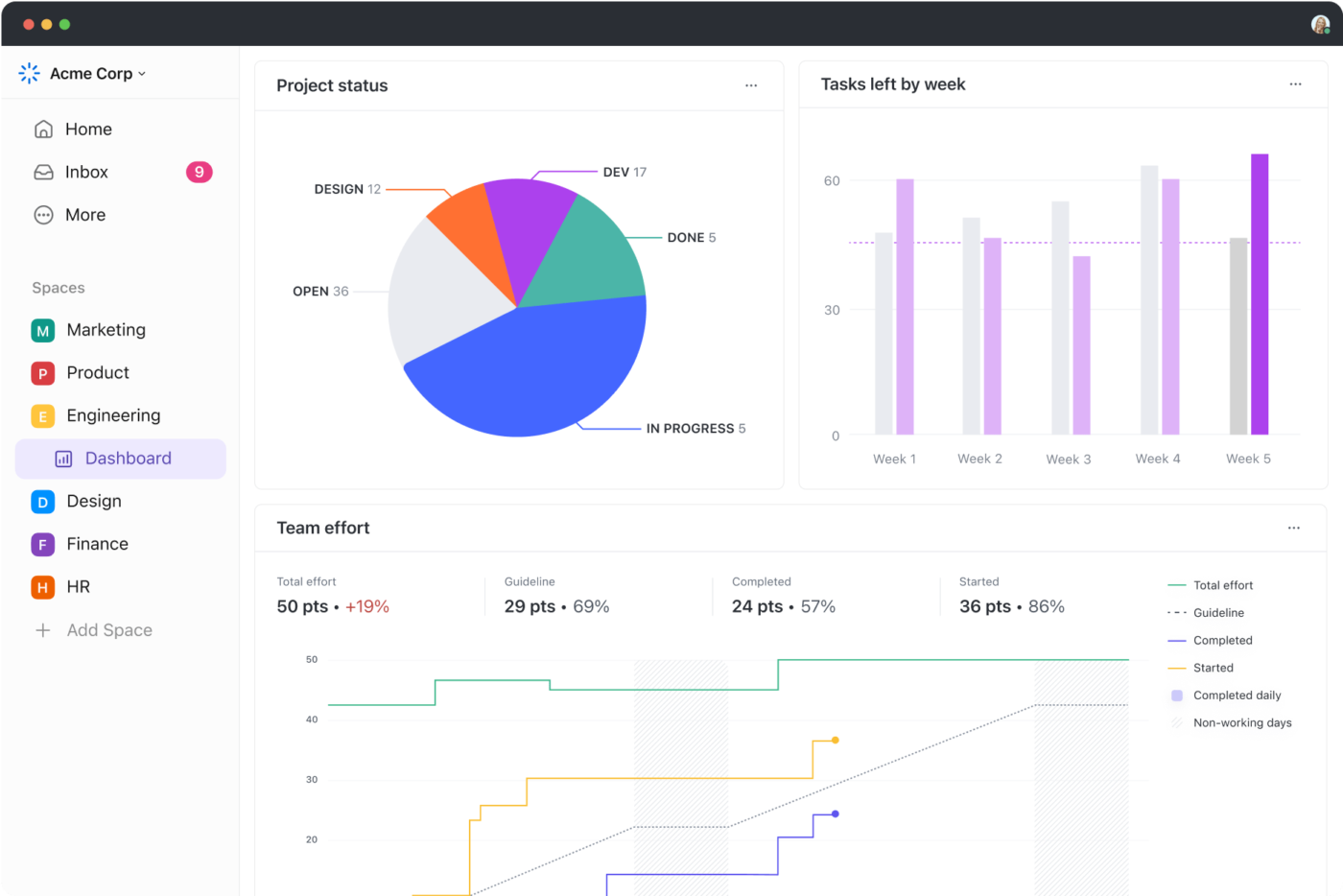
- Visualize scope progress: Track completed vs. pending deliverables
- Monitor resource utilization: See which team members are overloaded
- Detect scope creep early: Spot deviations before they become major issues
💡 Example: If a project expands beyond its initial scope, a Scope Creep Dashboard can highlight areas where work has exceeded original agreements.
Best Practices in Scope Management
Looking at the most successful project management examples, you’ll see that a well-managed scope leads to better outcomes, fewer delays, and smoother execution.
Here are some tips to help you manage project scope effectively:
- Set aside time regularly to check in on your project’s scope
- Always document updates clearly and make sure your stakeholders agree and understand changes
- Keep communication open and ongoing—this means talking regularly with your team, clients, and sponsors
- Use project management solutions like ClickUp to help teams track scope updates in real-time
- Hold frequent check-ins or meetings to quickly clear up confusion and keep everyone aligned
Agile methodologies and Scrum in project scope management
Agile methodologies, especially scrum project management, are great for managing changes flexibly. For example, practices like daily stand-ups and retrospectives encourage constant communication and quick feedback.
Break the project into small, manageable two to four-week cycles where teams focus on specific project deliverables.
ClickUp has everything you need to manage sprints, track tasks, and keep your project management team on the same page.
- Streamline Agile processes with the ClickUp Agile Scrum Management Template, enabling teams to track backlogs, manage sprints, and oversee testing phases
- Plan and execute sprints effectively using ClickUp’s sprint management features, which help in organizing tasks, setting priorities, and ensuring timely deliveries
- Facilitate efficient daily stand-ups with ClickUp Daily Stand-up Meeting Template, ensuring that teams stay aligned, address challenges promptly, and keep the momentum going
- Set up automatic progress updates and stand-ups with the help of ClickUp Brain’s AI assistant
Manage Project Scope Effortlessly With ClickUp 🎯
With the right tools and best practices, you can keep your project on track, avoid scope creep, and confidently meet deadlines.
ClickUp makes it easier by providing ready-to-use templates, scrum-friendly workflows, and real-time tracking right under one roof. Whether you’re managing tasks, updating project scope statements, or handling project planning, ClickUp keeps everything organized and clear. No more miscommunication or last-minute surprises!
So, why juggle multiple tools when ClickUp has it all?
Sign up for ClickUp today! 🙌


